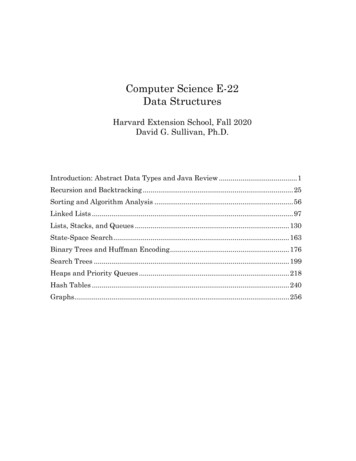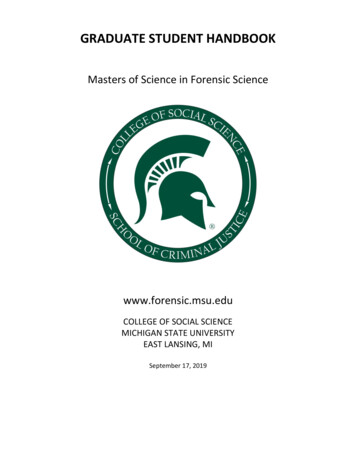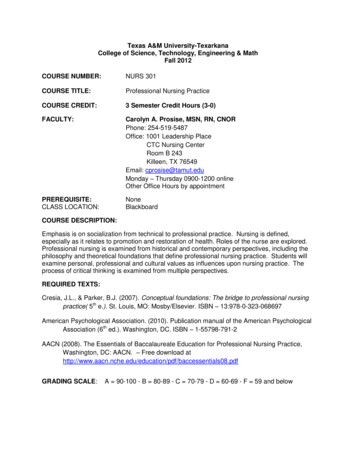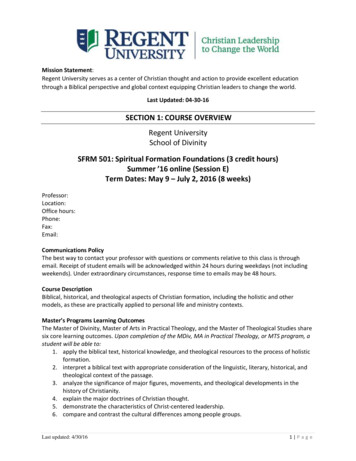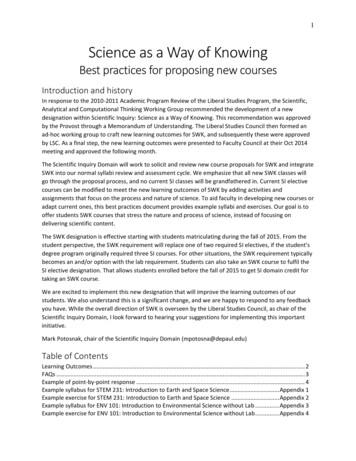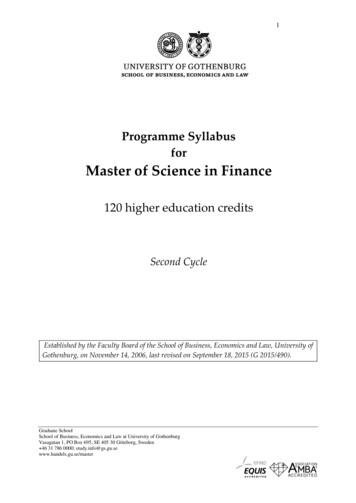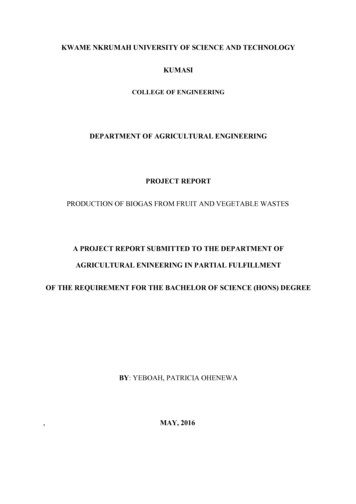
Transcription
KWAME NKRUMAH UNIVERSITY OF SCIENCE AND TECHNOLOGYKUMASICOLLEGE OF ENGINEERINGDEPARTMENT OF AGRICULTURAL ENGINEERINGPROJECT REPORTPRODUCTION OF BIOGAS FROM FRUIT AND VEGETABLE WASTESA PROJECT REPORT SUBMITTED TO THE DEPARTMENT OFAGRICULTURAL ENINEERING IN PARTIAL FULFILLMENTOF THE REQUIREMENT FOR THE BACHELOR OF SCIENCE (HONS) DEGREEBY: YEBOAH, PATRICIA OHENEWA,MAY, 2016
KWAME NKRUMAH UNIVERSITY OF SCIENCE AND TECHNOLOGYKUMASICOLLEGE OF ENGINEERINGDEPARTMENT OF AGRICULTURAL ENGINEERINGPROJECT REPORTPRODUCTION OF BIOGAS FROM FRUIT AND VEGETABLE WASTESA PROJECT REPORT SUBMITTED TO THE DEPARTMENT OFAGRICULTURAL ENINEERING IN PARTIAL FULFILLMENTOF THE REQUIREMENT FOR THE BACHELOR OF SCIENCE (HONS) DEGREEBY: YEBOAH, PATRICIA OHENEWASUPERVISOR: PROFESSOR EBENEZER MENSAHCO-SUPERVISOR: DR. GEORGE YAW OBENGMAY, 2016
DECLARATIONI Yeboah Patricia Ohenewa, declare that I personally undertook this project and it has notbeen produced anywhere for award of a degree except other people’s works cited which havebeen dully acknowledged. .YEBOAH PATRICIA OHENEWA .DATE(STUDENT) .PROF. EBENEZER MENSAH .DATE(SUPERVISOR) .DR. GEORGE YAW OBENG DATE(CO-SUPERVISOR)i
ABSTRACTOrganic waste was recognized as a source of energy for the first time when Davy in 1808recognized that methane was produced from decomposition of cattle manure. Biogas is aflammable gas composed mainly of a mixture of methane and carbon dioxide. Biogasgenerating technology is a favourable dual-purpose technology, at present; Biogas that isgenerated can be used to meet energy requirements and also the secondary product of theprocess is a sludge residue (digestate) that can be directly used as soil amendment or asstarting material for high quality compost preparation. In principle, many types of biomasscan be used for biogas production. In Ghana, the commonest and most importantcommodities to find in abundance on the market are fruits and vegetables. Its production andconsumption rate has been increasing yearly, consequently generating high volumes of waste.Fruit and vegetable wastes are highly perishable and this makes their landfill disposal quitechallenging, thus, this generates high environmental complications even for short-termdisposal. Conversion of these fruits and vegetable wastes to produce biogas provides someenergy that can have a beneficial effect on the environment. This study presents results onbiogas production from fruits and vegetables waste materials and a mixture of fruit andvegetable waste materials. It was observed that the highest biogas yield of 996 ml wasrecorded for vegetable waste followed by the mixture of fruit and vegetable waste which had668 ml of biogas. The results obtained shows that difference in the production of biogas to alarge extent depends on the nature of the substrate and factors such as pH and C: N ratio.Throughout the entire anaerobic digestion process, the ambient temperature for digestionranged from 26 C to 32 C and there was little temperature variation effect on biogasproduction once biogas production began.ii
DEDICATIONEbenezer! This is how far the Lord has brought me. I dedicate this thesis work to the LordAlmighty for His guidance and protection, to my father; Mr. Seth Yeboah, my mother; Mrs.Gladys Yeboah, my siblings; Mrs. Naomi Fuseini and Ms. Priscilla Yeboah for their love,support, unselfish sacrifices, prayers and encouragement that urged me on through myacademic journey.I also dedicate this work to Technology Consultancy Centre (TCC) KNUST, MIT D-LabInternational Development Innovation Network (IDIN) Project for the financial support tosee me through my project work.iii
ACKNOWLEDGEMENTSI acknowledge God almighty for His unfailing love, guidance, mercies and immense favour,bestowed upon me, that has brought me to a successful completion of my project work.I also take this opportunity to express my profound gratitude and deep regards to mysupervisor, Prof. Ebenezer Mensah for his exemplary guidance, monitoring and providingvaluable insights leading to the successful completion of this project study. The blessing, helpand guidance given by him time to time shall carry me a long way in the journey of life onwhich I am about to embark. I also take this opportunity to express a deep sense of gratitudeto Dr. George Yaw Obeng for his cordial support, valuable information and guidance, andalso for teaming up with my supervisor to link me up with the organisation that funded myresearch work; Technology Consultancy Centre (TCC) KNUST, MIT D-Lab InternationalDevelopment Innovation Network (IDIN) Project without which this project would not havebeen possible.I am grateful to lecturers of the Department of Agricultural Engineering, for the valuableinformation provided by them in their respective fields. I sincerely appreciate the inspirationand support of all those people who have been instrumental in making this project a successmost especially my teaching assistant, Mr. Bright Mensah, Ms. Nomo Ernestina and Mr.Samuel Acquah and all the technicians at the Soil Science laboratory. Lastly, I place a deepsense of gratitude to my family and my friends who have been constant source of inspirationduring the preparation of this project work.iv
TABLE OF CONTENTSDECLARATION . iDEDICATION . iiiACKNOWLEDGEMENTS . ivTABLE OF CONTENTS . vLIST OF TABLES . viiLIST OF FIGURES . viiiCHAPTER ONE . 1INTRODUCTION . 11.1 Background. 11.2 Problem statement . 31.3 Justification. 31.4 Objectives . 41.4.1 Main objective . 41.4.2 Specific objectives: . 4CHAPTER TWO . 5LITERATURE REVIEW . 52.1 Anaerobic digestion . 52.1.1 Overview . 52.1.2 Stages of anaerobic digestion . 62.1.3 Factors that Influence Anaerobic digestion . 82.2.1 Generation of wastes . 122.2.3 Management of wastes produced . 132.3 Biogas production from fruits and vegetable waste . 14CHAPTER THREE . 16MATERIALS AND METHODS . 163.1 Study Area . 163.2 Materials . 163.3 Methods . 173.3.1 Substrate Collection. 173.3.2 Sample Preparation . 173.3.2.1 Preparation of slurry . 183.3.2.2 NaOH pre-treatment of slurries . 183.3.3 Experimental Design and Setup . 18v
3.3.3.1 Construction of digesters . 183.3.3.2 Construction of receivers . 193.3.3.3 Operation of digesters and receivers . 203.4 Collection of Data and Analysis . 213.4.1 C/N ratio . 213.4.2 pH determination . 213.4.3 Temperature measurement . 223.4.4 Biogas yield/production. 223.4.5 Data Analysis. 22CHAPTER FOUR . 23RESULTS AND DISCUSSION. 234.0 C/N ratio of feedstock . 234.1 pH values of the various feedstock before and after adding 5M NaOH. 244.2 Temperature and biogas yield . 254.3 Daily biogas yield . 264.4 Total volume of biogas produced . 27CHAPTER FIVE . 30CONCLUSION & RECOMMENDATIONS. 305.0 Conclusion . 30REFERENCE . 31APPENDICES . 35vi
LIST OF TABLESTable 1. C/N ratio for specific fruits and vegetable waste . 23Table 2. Average C/N ratio of the feedstock . 24Table 3. pH values of the various feedstock before and after adding 5M NaOH. . 24vii
LIST OF FIGURESFigure 1. Various stages of anaerobic digestion . 8Figure 2. Contruction of the digester and receivers. . 20Figure 3:Schematic Diagram of Experimental Setup . 21Figure 4. Experimental setup . 21Figure 5. Biogas yield against temperature of various feedstock. . 25Figure 6. A graph of biogas yield against time over a period of 30 days. . 26Figure 7: Total biogas yield of various feedstock . 27viii
CHAPTER ONEINTRODUCTION1.1 BackgroundThe general technology of anaerobic digestion of complex organic matter is well known andhas been applied for years as part of domestic sewage treatment to stabilize organic wastes(Sagagi et al., 2009). Biogas was produced as early as 3000 years ago from animal dung,human sewage and organic waste consisting generally of household waste, agricultural waste,human
Gladys Yeboah, my siblings; Mrs. Naomi Fuseini and Ms. Priscilla Yeboah for their love, support, unselfish sacrifices, prayers and encouragement that urged me on through my academic journey. I also dedicate this work to Technology Consultancy Centre (TCC) KNUST, MIT D-Lab

